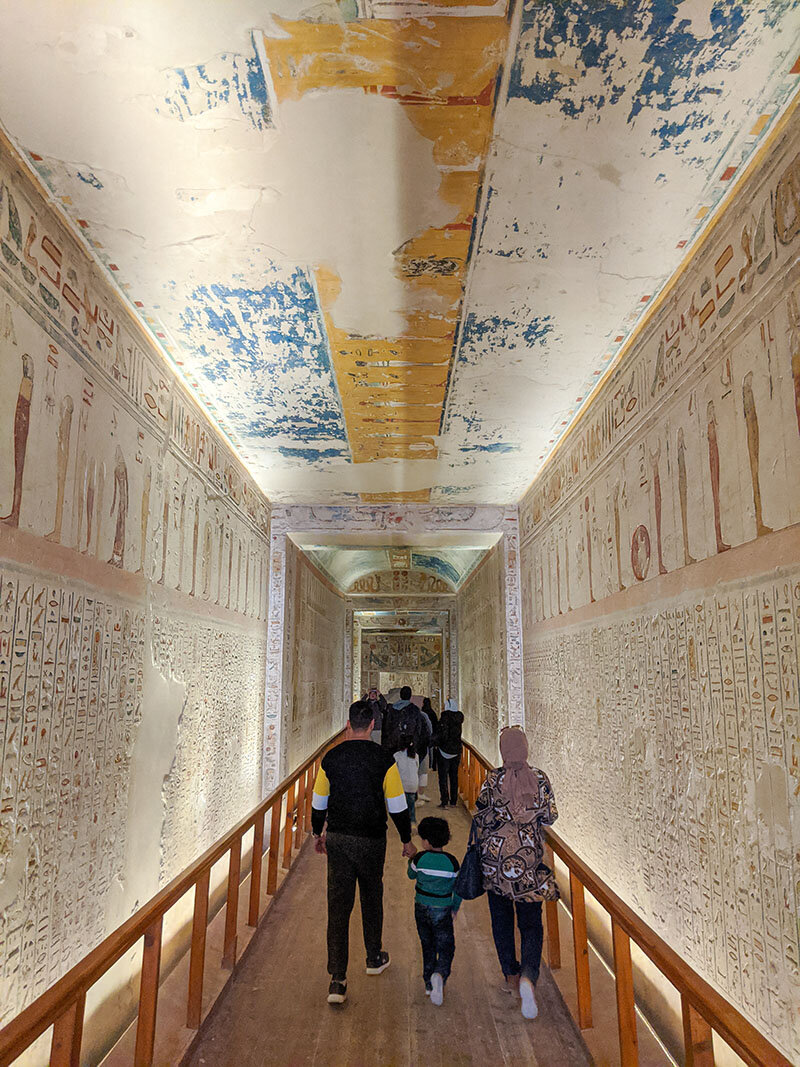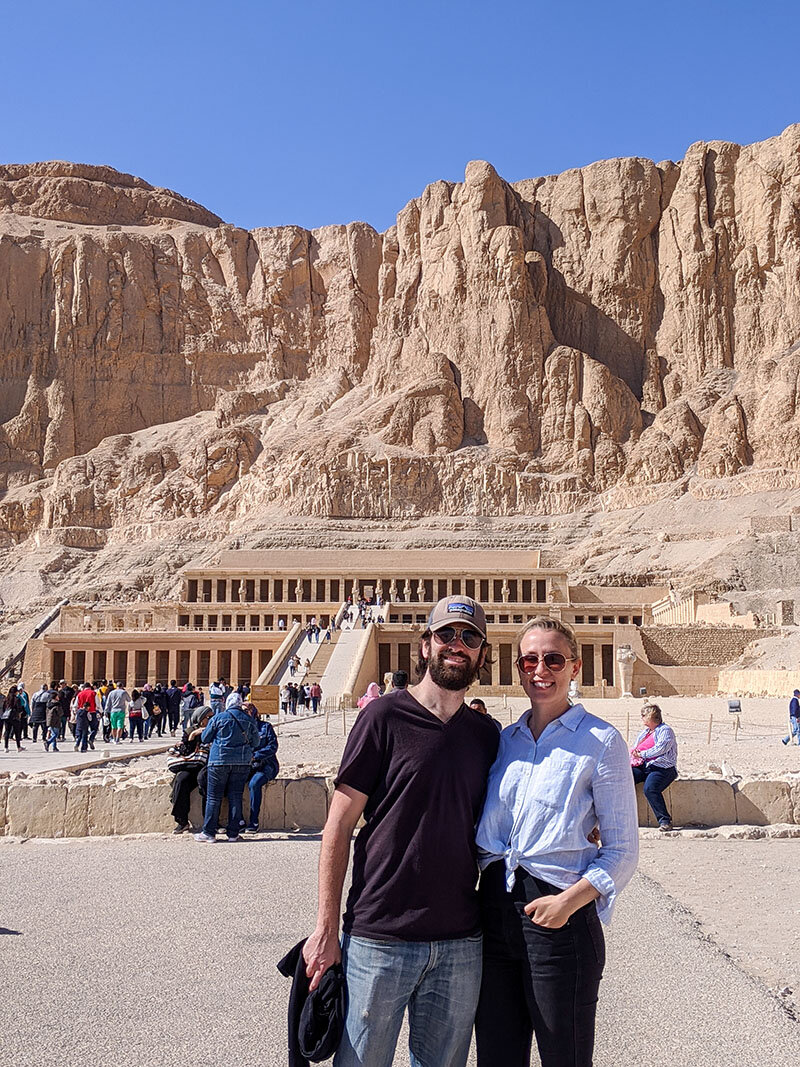After a hectic and eventful few days in Cairo, we got on a train and made our way down to Luxor. The train took over 10 hours, but the train was comfortable and had a regular drink and snack cart so we were completely fine. A lot of backpackers will take the night train so that they don’t waste any daylight and don’t have to pay for an extra night of lodging. We arrived in Luxor at night time and already felt more comfortable than we had in Cairo because of the city’s size. Our hotel was in walking distance from the train station, so everything just seemed more manageable. With that said, since Luxor is smaller their SOLE focus is on tourism. What does that mean to you, the traveler? You are going to get a lot more people staring at you, asking you if you need help, kids asking for money, being told, “nice mustache” (they loved my facial hair) and saying, “ohhh yeah” to Caitlin. At no point did we feel unsafe, just a little overwhelmed because these “salesman” will wait right outside the door to the hotel. It’s non-stop.
We stayed at the Iberotel which like I said, was walking distance to the train station. That was a plus. It is also located right on the Nile and has a pool that is right on the Nile. Therefore, our first day was spent soaking in the Egyptian rays by the pool. Our second day was our big one. Just like Giza, we decided to book a private tour that would take us to all of the main tourist attractions. We enjoyed our tour guide much more this time because she interacted with us more, gave us more time to walk around the sites on our own and answered any questions we had. We don’t know if it’s a societal thing or just how the tour guides are instructed, but we noticed with both of our guides in Egypt, their answers were rarely expounded upon. We would ask a question, they would give a very short answer and just kind of let it die there. This was very different from some of the other countries we’ve visited where the guides are very outgoing and chatting non-stop about the country, its history, or about their own upbringing. The regular small talk questions about where we/they are from, why Egypt, where else we/they have been, etc. were non-existent. Just an observation-we may reliant on small talk and when it’s not there (and you’re used to it) it feels awkward and odd.
Here are the main attractions to see in Luxor and where most tour groups will take you. A reminder that Luxor was the capital of the “New Kingdom” from years 1550-1050 B.C..
Temple Of Karnak - This is more of a complex with a mix of temples, obelisks, and other buildings. Construction at the complex began around 2000-1700 BC. This was our first stop, so we didn’t know what to expect. The pyramids were incredible in Giza but other than that, we didn’t see much. The size and detail on the temples and tombs in Luxor were 100% worth the long trip.
Valley of the Kings - For me this was the highlight of our whole time in Egypt. For a period of nearly 500 years from the 16th to 11th century BC, tombs were built for the pharaohs underneath a large mountain that was naturally shaped like a pyramid at the top. If you like seeing pictures of tombs, learning about King Tut, and watch movies like “The Mummy,” this is the place you want to see. At this time there are about 65 known tombs that have been discovered, but they are still digging and discovering new ones. When you arrive at the Valley, you are given a ticket that gives you access to three tombs of your choice. Each tomb has a sign and map that shows the chambers you will be entering. Luckily for us, our guide knew the best three to go to in terms of size, detail, color, etc. The detail and the fact that the original color was still so bright after almost 4000 years in these tombs was indescribable. We decided to forego the King Tut tomb which costs extra because everything we had read said that it’s nothing different than any of the other ones we had seen (it gets all the attention because it was found most recently and was completely in tact without having been raided first). I was most excited for the Valley of the Kings and it lived up to my internal hype.
The Temple of Queen Hatshepsut - The temple was built by Queen Hatshepsut who ruled Egypt for about 20 years, approximately 1490-1469 B.C., and the only woman pharaoh who reigned ancient Egypt. Her reign was one of the most prosperous and peaceful in Egypt’s history, which our guide made to sure to tell us, that’s what happens when a woman is in charge :-) While the Valley of the Kings was the most impressive site, this was the most impressive structure.
The Colossi of Memnon - This was a quick stop for some pictures and was the mortuary temple of Amenhotep III.
Temple Of Luxor - It was built by Amunhotep III in the 18th Dynasty in the New Kingdom and it was completed by Ramses' II during the 19th Dynasty. It is a smaller version of the first temple we went to, but still just as impressive. Unfortunately we were just a little early because they are building a walkway which will be lined with sphinx for 2 miles and lead to the Temple of Karnak.
On our last day we went to the museum of Luxor, which we would recommend if you are there any longer than a day. It’s a smaller museum, is very well laid out and modern. We also ate at one restaurant that we strongly recommend called Sofra. That concluded our few days in Luxor. If you are coming to Egypt then I would say Luxor is a “can’t miss”. It’s a little difficult to get to because it’s annoyingly far for a train but really short for a plane. You shouldn’t miss it if you have already gone as far as Cairo. We got more attention in Luxor than Cairo and maybe because we were starting to get used to it, we just weren’t as stressed out and overwhelmed in Luxor. There aren’t many places in the world that has so much to see and learn in such a small area.
























